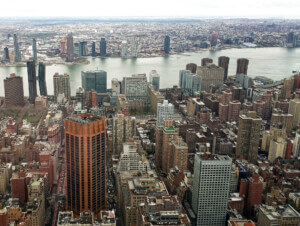Madison Square Garden has been on the move since its inception in 1879 as a 10,000-square-foot boxing, bike racing, and ice hockey venue in an old railroad depot at Madison Avenue and 26th Street. The facility later moved into an ornate Moorish-style building designed by famed Stanford White, architect of the Penn Station, which the arena notoriously replaced at its fourth and current home on 33rd Street in Midtown (after a brief stop on 50th Street). Now, if community boards, civic and planning groups, and Manhattan Borough President Scott Stringer get their way, the venue will be sent packing once again.
With MSG’s special use permit to operate at its current site—originally issued in 1963 with a 50-year term—up for review, opposition is now mounting to relocate the arena, increase the capacity of one of the city’s biggest transportation hubs, and restore some sense of “civic dignity” to the site of New York’s most famous demolished train station. Last month, Community Boards 4 and 5 unanimously voted to deny the arena’s owners request for a permanent extension of the permit, which would have guaranteed the arena’s site for eternity. Seconding that decision, New York Times architecture critic Michael Kimmelman, who has supported moving the arena for over a year, penned a scathing screed on why the arena must go:
The last thing New York needs is to enshrine the aging and oppressive Garden, which may be the world’s most famous arena but is also one of the ugliest and, for millions of commuters using the station trapped beneath it, a daily blight.
On March 21, the Municipal Art Society and the Regional Planning Association joined forces to push for reconsidering MSG’s current site. According to a joint statement, the groups want “to overhaul Penn Station and reconsider the location of Madison Square Garden atop our busiest and most vital transportation hub.” The two groups issued a statement:
Penn Station’s problems aren’t only aesthetic. The station is so space-constrained that it struggles to accommodate passenger traffic from the rail systems that currently use it or absorb future passenger growth and new services such as high-speed rail. While large cities around the world—and New York’s own Grand Central Terminal—have built and transformed rail stations into appealing destinations for residents and visitors, Penn Station has never been a magnet for west Midtown.
Manhattan Borough President Scott Stringer issued his own opinion this week on the matter, proposing a limited ten-year extension to MSG’s special use permit, noting that the arena “stifles” Penn Station’s ability to grow, which could bring negative long-term consequences to the city and region. Stringer noted in his press release that Penn Station already operates at well over 100 percent of its capacity, handling more than 640,000 people daily, triple the 200,000 capacity the station carried 50 years ago. With expansion on Manhattan’s West Side and proposed tunnels to New Jersey, estimates show that use will increase some 40 percent over the next two decades.
“It is time to build a more spacious, attractive and efficient station that will further encourage transit use, reduce driving into the city, and spur economic growth throughout our city and our region,” Stringer said in a statement. “While we need to ensure the Garden always has a vibrant and accessible home in Manhattan, moving the arena is an important first step to improving Penn Station.”
Among the challenges to updating Penn Station are the support beams for the arena, which land between tracks leading into the station. According to the New York Times, the station also fails to meet current fire codes and other safety regulations
MSG’s current site, Stringer continued in his press release, will ensure that Penn Station “remains a confusing, subterranean, three-level maze with indiscernible entrances, low ceilings, and exit points that are severely limited. It is simply unacceptable to continue to subject existing and future users to the current Penn Station. Failing to account for Penn Station’s current and future needs could have devastating effects and enervate New York’s ability to compete with world cities.”
His proposal called for a comprehensive study of the Moynihan-Penn Station area to create a master plan that could guide growth. During the ten-year extension, an alternative site for MSG could be found. While there has been no official proposal for a relocation site, several observers have issued their own recommendations. In another New York Times piece, Kimmelman suggested another site on the West Side such as the giant Morgan General Mail Facility that covers two entire blocks. Kimmelman conceded, however, “The point isn’t deciding which possible site is best right now. It’s knowing there are paths worth pursuing, and focusing the next decade on exploring them.”
The Dolan family, owners of MSG, will appear before the New York City Planning Commission and eventually the full City Council this summer to make their case for renewing the permit and keeping the arena at its current site. A public hearing at the Planning Commission is scheduled for April 10 and the RPA will be hosting a forum on the arena on April 19.










